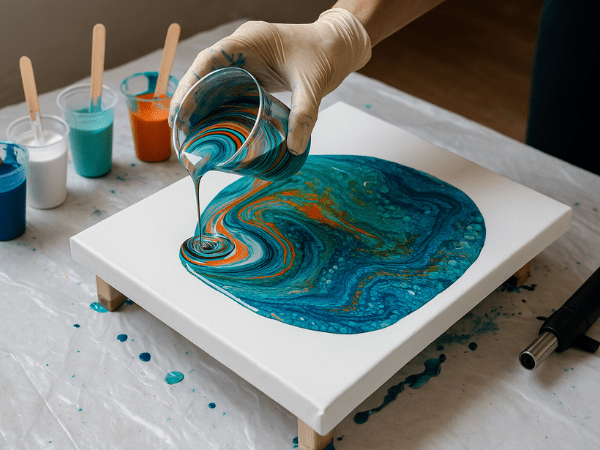
Step-by-Step Acrylic Pouring Techniques for New Artists
Are you more or less a beginner in the world of painting, wondering how acrylic pouring is done properly? This is a specific method that involves preparing the canvas, combining the paint with water and a pouring medium to get the best consistency and then pouring the paint on to the canvas using proper methods. If you are new to acrylic painting, here is a step-by-step guide that will help you to try acrylic pouring in stepwise techniques.
Prepare Your Canvas
First, you need a proper surface on which you have to pour your acrylic paint. Canvas is the surface used most often, although specially designed acrylic boards or wooden panel are also quite useful. Prepare your canvas surface in a proper way, with an acrylic gesso layer, so that there is better adhesion of paint and smoother flow.
You can get a smooth surface as well as manage to prevent too fast absorption of your paint. Allow the gesso to dry completely before you start mixing your paints. It is necessary to do an effective preparation, to be assured of the best outcomes.
Mix Your Paint
Based on the color scheme that you decide for your painting, you should choose your acrylic paints. If you are starting from scratch, try to buy acrylic color set online, available with various shades. This can allow you to experiment with different effects and moods. Mix your paint with a pouring medium, if you want to get the right pouring consistency. It is critical to get the texture right, so that there is uniform flow of your paint and no breaking apart.
Experiment with Techniques
When You mix your paints, you can try pouring them onto your canvas in various methods and in visually striking ways. The “Dirty Pour” is one popular method, where you have to layer multiple colors into one cup and then pour that mixture onto your canvas directly. It will allow the colors to interact with each other and give you unexpected beautiful cells and swirls.
The “Flip Cup Method” is another favorite technique, where you have to fill a cup with your layered paint mixture. Then, you have to place your canvas over the cup and flip the whole setup. Once you lift the cup, you will find the paint spreading across the canvas surface dramatically.
Pour and Create
When your paint is ready and you have chosen your technique, it is time for you to pour your paint. You should release your paint onto the surface of the canvas gently, either in a spiral pattern, wave pattern or any other pattern, or in a central location. The kind of pouring technique that you choose should depend on your selected technique.
Once the paint is poured on the canvas, gently tilt the surface in various directions, so that the paint can spread and cover the whole surface properly. Most of the covering will be done with the help of gravity, allowing the colors to blend and stretch in a proper way.
Use a small butane torch or some other heat tool, such as a hairdryer, if you want to improve your design further. You can make the air bubbles pop with heat and encourage cell formation, particularly if you have used silicone oil. With this step, you can add more complexity and depth to your work, and make it look more attractive.
Embellish and Protect Your Work
Once your painting gets dried, which can about 1 to 2 days depending on the thickness of your paint and the humidity in your working area, you can choose to embellish it. You can use fine brushes for metallic highlights, dots or detailed line. This is where you need to have the best paint brushes for acrylic paint, so that you can work with precision.
When you get quality brushes with fine bristles, you can expect to create more accurate artwork without fraying or shedding. Consider applying a sealant when you want to finish your piece. With a glossy varnish, you can make your colors look more beautiful. You can also manage to protect the surface from UV damages, scratches and dust.
With this final step, you can preserve the brilliance of your work for a long time to come and then display or frame it proudly. If you plan to build a collection of artwork and leave a legacy, it is essential to do this in a proper way and bee proud of your creations.
Final Words
As you might have understood by now, acrylic pouring is not something very difficult. You just need to have a proper idea about the various techniques that can help you to go about the process more easily. And of course you need to invest in the best art supplies, so that you can get better results and a more enjoyable creative experience.
